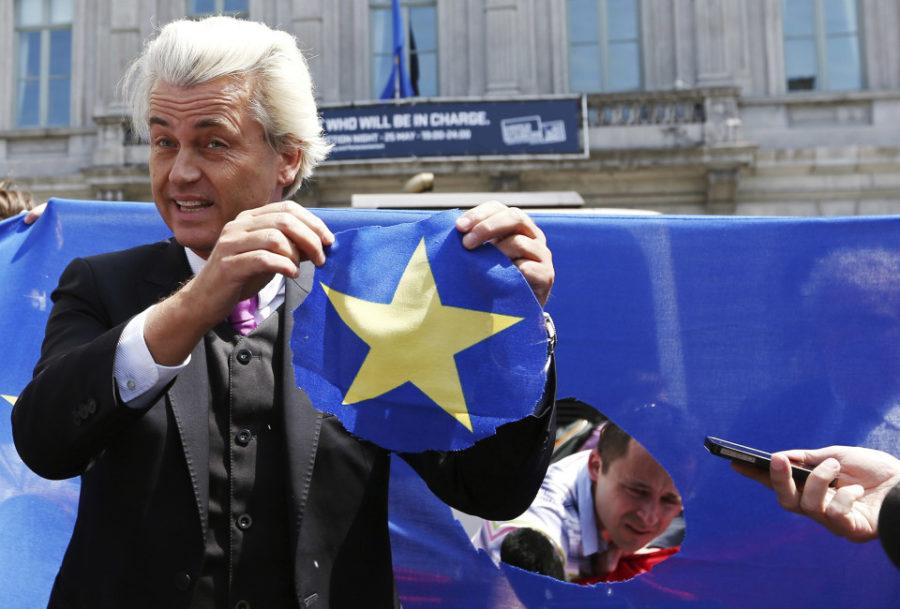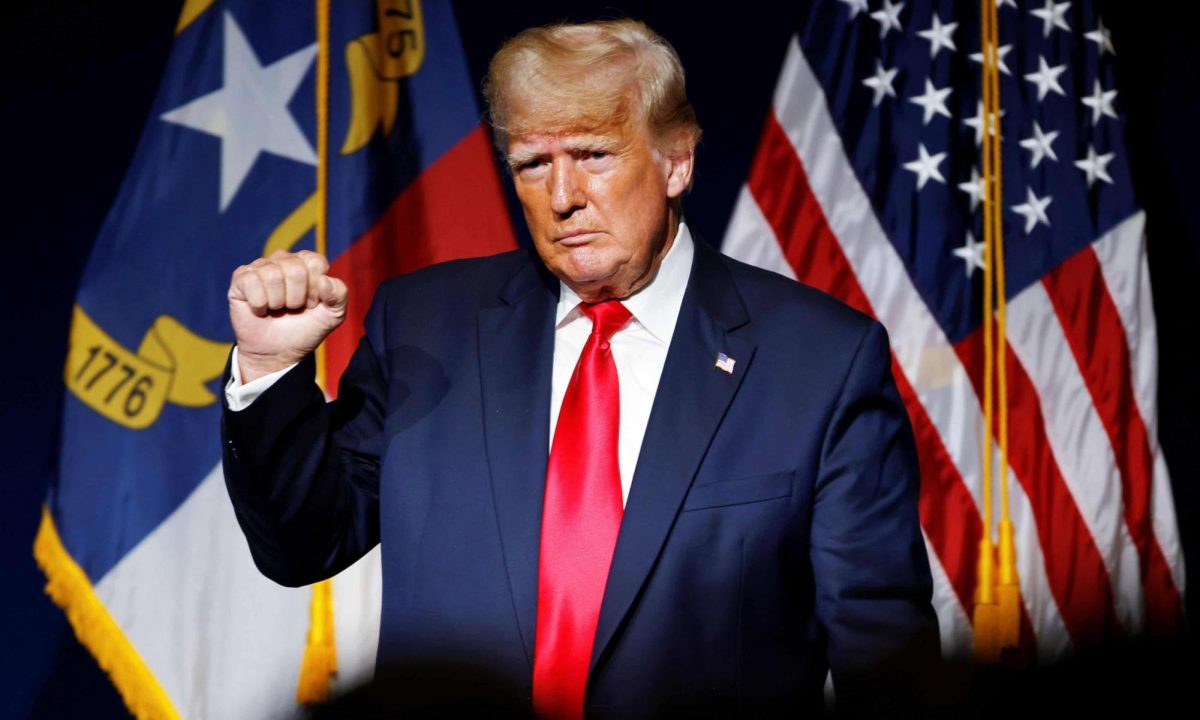A Look at the State and Future of the Insurgent Right Wing Populism
Dutch far-right Freedom Party (PVV) leader Geert Wilders holds a star he had just cut from the European Union flag during a demonstration in front of the EU Parliament in Brussels May 20, 2014. It was meant to be the campaign launch of a new Eurosceptic alliance, but the planned April 16 meeting starring France’s Marine Le Pen and Dutchman Geert Wilders in Strasbourg, home of the European Parliament, never took place.
March 22, 2017
A new political movement and faction has erupted across almost every democracy and forum in the West: right wing populism. While it did exist in a very radical form for a very long time, 2016 marked the emergence of a new force to be reckoned with, and a host of new political parties to dominate elections. Most obviously, Donald Trump and Brexit mark the two successes of this movement thus far; across the West, in nations such as the Netherlands, Germany, Sweden, France, Austria and others, the far right has become a viable political platform.
Of course, white supremacy and nationalism has been around for hundreds of years. But it was in this election in particular that Americans became familiar with the “alt-right”, the internet cult of right wing fanaticism, and “trolls”. Media outlets, on the left in particular, penned exposés meaning to explain the movement that controls the corners of the internet. Hillary Clinton threw every one of them into a “basket of deplorables”. Most seem to agree that this faction is one of illiberal democrats, who mean to have power restored to the people, but do not agree with the relatively liberal platforms of mainstream Democrats or Republicans. Inspired by their scion, Donald Trump, they flout the conventions of discourse and the limitations of policy by, at times, outright championing racist policies, strict border control, gun rights, contrasted with an economic platform weary of Republican free-marketeering as well as Democratic taxation.
In America, at least, there is no legitimate political platform for this faction outside of Donald Trump himself and the fringe internet outlets where it thrives. But in Europe, where the far left has also been a longtime player in politics, the far right has real, functional candidates and political power. The primary difference is that the system of parliamentary representation across Europe facilitates the existence of multiple parties; winning a small share of the vote might win your party a few seats here and there. In America of course, not winning the most votes means you get nothing. To get power in the Congress, a politician needs the most votes in the state or the district. This is why America has a limited landscape of parties (2, to be precise), and why parties so rarely come and go. In Europe, new parties are started all the time and veteran parties can wither in the span of an election cycle.
It’s quite obvious that right wing populism has found a permanent niche in American politics. But whether they can ever meaningfully attain power in our homeland is yet to be seen; remember, the Congressmen and Senators that are now in the Republican Congress were elected on the platforms, mostly, of either moderate conservatism or libertarian conservatism, depending on their home state. In the future of course, the Republican party might begin to field candidates more in line with the hardline views of the populists should they assess that a voter base exists for such candidates. So in America, for now, they are a minor force, harassing the Republican leadership and waging an insurgency online.
But looking again to Europe, there are a number of parties that have fielded candidates which have attained serious success. In Austria, the runoff election was between the far-right Norbert Hofer and a leftist rival; while the right wing populist did not prevail, the vote was only between a couple percentage points. In the Netherlands, populist Geert Wilders led the polls for a very long time before having a disappointing election night; however, he did win roughly 20 seats to the 33 accrued by the incumbent party in power. Again, while not winning the entire election, Wilders, who ran on the joint promises of banning the Quran and closing all mosques in the Netherlands, had a serious chance of winning the most votes and seats. Of course, Britain has seen the success of the Eurosceptic Brexit movement.
In future elections coming up quite soon, the AfD (Alternative for Germany) will attempt to pull off an upset victory against Angela Merkel, as polls show the incumbent Merkel’s party, the Christian Democrats, to be holding a solid lead. The far right AfD previously won the home district of Angela Merkel, and the beleaguered German leader has seen her popularity plummet after her handling of the migrant crisis. Germany seems to be ready for a far right populist challenge. In France, right wing populist Marine Le Pen has long held a lead for the first round election coming up in a few months, but pundits expect her to fail in the runoff election. Her party, the National Front, had a strong showing in the first round of Parliamentary elections last year, but failed to win any seats due a poor showing in the second round. France too has a viable far-right candidate.
In Hungary, Bulgaria, and Poland, and many Eastern European countries as well (viewed as more traditionally conservative nations), far right populists are already in power, and are doing all that they can to eject refugees and migrants from their nations. Hungary’s Viktor Orban has violated the will of the EU to maintain the level of immigration control he promised his people; Poland rejected the EU’s migrant quotas; Bulgaria ordered mass deporations of migrants after riots in camps. Of course, in Russia, the traditionalist right, spearheaded by world-class hacker Vladimir Putin, has been in power for a very long time.
That’s the state of the far right in the West. It’s also worth speculating about its future. Much of what propelled Donald Trump and Brexit to success was a desire for change. Many Trump voters didn’t identify as right wing populists or even like Trump. If Trump fails to deliver change, his brand of right wing populism might collapse, with only online contingents continuing to make trouble, as they did before. If Trump delivers meaningful change, then the desire of the people for change might be satiated and thus the voters that elected him might drift back to more mainstream platforms. Alternatively, as the left becomes more and more leftist and progressive, one could see the right go further right. Some Republican representatives, such as David King, have been scolded by moderate establishment conservatives (Jeb! Bush, to be specific) for espousing views too far to the right. Whether younger generations are more conservative is yet to be seen in the voting record. Only time will tell in America.
In Europe however, the record shows that the far right is quite popular with young people. In France, Marine Le Pen leads polling among 18-24-year-olds with 33% in the first round of presidential voting — her largest support from any age group. Geert Wilders has 27% support from 18-25 year olds, up 5-10 points from his national average. The story is the same in other countries. If the youth can carry enough clout to give a third of their votes to populists, then those populists could seriously improve their chances of success. Nevertheless, the coalition-forming basis of government means it will be difficult for radical parties to accomplish much as other parties tend to be moderate or leftist, fuelling long-term support for the far right.






